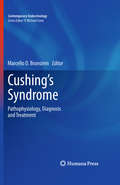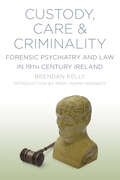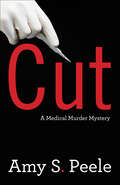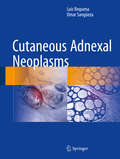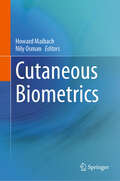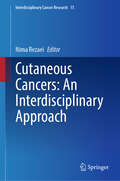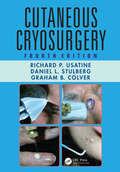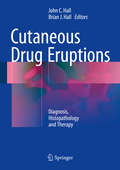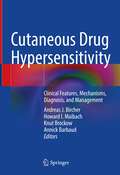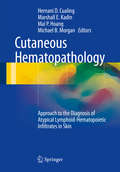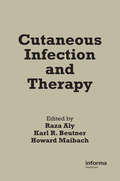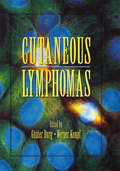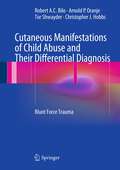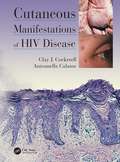- Table View
- List View
Cushing's Disease (Endocrine Updates #31)
by Beverly M. Biller Brooke SwearingenIn Cushing's Disease, leading authorities in the field offer a thorough review of the pathogenesis, diagnostic algorithm and treatment options for this complex disease. Beginning with a fascinating history of Cushing's disease that outlines its historical significance to both endocrinology and neurosurgery, the book goes onto to cover the full range of important issues, including the molecular pathogenesis of Cushing's, anatomic pathology, the diagnosis of Cushing's syndrome, the differential of pseudo-Cushing's syndromes, hypercortisolemia, surgical removal of the corticotroph adenoma, post-operative management and assessment of remission, radiotherapeutic options, and the exciting developments in medical therapy. In addition, the book also addresses Cushing's disease in the pediatric population, given that its clinical manifestations and impact on growth can be severe; silent corticotroph adenomas as a distinct clinical entity; diagnosis and management of Cushing's disease during pregnancy, bilateral adrenalectomy, and, finally, the long-term psychological manifestations of hypercortisolemia. Comprehensive and an invaluable addition the literature, Cushing's Disease is an essential reference for enhancing diagnosis and treatment of this debilitating disorder.
Cushing's Syndrome: Pathophysiology, Diagnosis and Treatment (Contemporary Endocrinology)
by Marcello D. BronsteinCushing´s syndrome is a relatively rare clinical disorder that is associated with many co-morbidities such as systemic hypertension, diabetes, osteoporosis, impaired immune function and growth impairment in children, all of which severely reduce quality of life and life expectancy. Cushing's Syndrome: Pathophysiology, Diagnosis and Treatment reviews the difficulties in distinguishing Cushing's syndrome from these and other common conditions, such as central obesity, menstrual irregularity and depression. It also provides state-of-the-art information on various strategies to establish the diagnosis of Cushing's syndrome and the differential diagnosis among its diverse etiologies, as well as therapeutic approaches. Additionally, a range of conditions that represent challenges for the diagnosis and treatment--such as renal failure, pediatric age, cyclic hypercortisolism, and pregnancy--are covered in detail. A valuable resource not only for endocrinologists but also internal medicine physicians, gynecologists, pediatricians, , pituitary surgeons and urologists, Cushing's Syndrome: Pathophysiology, Diagnosis and Treatment provides insights by experts that will help all physicians dealing with Cushing´s syndrome to expand their knowledge about the condition and provide targeted, comprehensive care.
Custody, Care and Criminality: Forensic Psychiatry and Law in 19th Century Ireland
by Brendan Kelly Harry KennedyIn this fundamentally important work, Professor Brendan Kelly explores the background to Irish psychiatry in the nineteenth and early twentieth centuries, charting its progress and development. Using detailed case studies from the original records, the author examines some of the more unusual treatments explored and the history behind them. What emerges is a collection of piercing, untold stories of crime and illness, drama and tragedy. They are filled with a sense of the powerlessness of those detained and the dedicated – and sometimes misguided – enthusiasm of those trying to help. This book sheds important light on the foundations for the treatment of mental illness in Ireland.
Customer Sense
by Aradhna KrishnaAn insightful look at how touch, taste, smell, sound, and appearance effect how customers relate to products on a sensory level, and how small sensory changes can make a huge impact. Customer Sense describes how managers can use this knowledge to improve packaging, branding, and advertising to captivate the consumer's senses.
Customers and Patrons of the Mad-trade: With the Complete Text of John Monro's 1766 Case Book
by Jonathan Andrews Andrew T. ScullAn important, nuanced, and fascinating account of the socio-cultural milieu that shaped and constituted the 18th-century mad-trade, centered around the clinical practice of the most famous psychiatrist in 18th-century England.
Customized Laser Vision Correction
by Mazen M. Sinjab Arthur B. CummingsThis book addresses customized laser vision correction, an integral management option for the treatment of irregular corneas. This type of treatment reshapes the corneal surface in order to improve both the quality and the quantity of vision by reducing high order aberrations. Beginning with an introduction to the basics of this science, each type of customized laser vision correction is discussed in a clear and didactic format for rapid attainment of information. Throughout this practical clinical guide, examples are supported with the most recent scientific material and a step-by-step systematic methodology is included to fit all levels of ophthalmologists.
Cut Down to Size: Achieving success with weight loss surgery
by Jenny RadcliffeCut Down to Size covers everything you need to know about bariatric surgery, from referral through to the challenges you may face after surgery. Most people who seek weight loss surgery have struggled for many years to control their eating, and have experienced increasing health limitations, self-consciousness and discrimination. People see weight loss surgery as their last chance for a better, more normal life. While hopeful fantasies about an alternative future make it hard to contemplate the risk of failure, some patients experience considerable emotional or physical problems. This book offers insight into the realities of living with weight loss surgery, and practical exercises help you think through your emotional readiness, social circumstances and eating habits that could determine the success of surgery. Active preparation for surgery by making psychological and lifestyle changes puts you in the best position to achieve better health and emotional wellbeing. Cut Down to Size is the first book to focus on the psychological and social aspects of weight loss surgery and will be of interest to health professionals as well as anyone contemplating weight loss surgery. By sharing the experiences of other bariatric patients, the reader can appreciate the nature of life after surgery and make a judgement about their capacity to cope with these demands.
Cut: A Medical Murder Mystery
by Amy S. PeeleWhile the federal government is launching a national investigation on the “equity” of organ distribution, a female tech CEO flies across the country to get a liver transplant. Soon, well-respected transplant nurse Sarah Golden and her best friend, Jackie, find themselves tangled up in an intense plot to uncover the answer to the question on everyone’s mind: Can you buy your way up to the top of the waiting list? Their pursuit of justice brings them to Miami, San Francisco, and Chicago―a sometimes fun, sometimes dangerous roller coaster ride from which they barely escape with their lives.
Cutaneous Adnexal Neoplasms
by Luis Requena Omar SangüezaThis superbly illustrated book is the most comprehensive available guide to adnexal neoplasms of the skin. More than 70 entities are described in individual chapters that follow a uniform structure: historical review, clinical features, histopathology, histogenesis, immunohistochemistry, molecular anomalies, and treatment. Readers will find state of the art knowledge on all aspects, including the cytogenetic and chromosomal abnormalities associated with each neoplasm. Without exception, the illustrations are high-quality, full-color, original digital pictures. The histopathology images are taken from perfectly cut and stained sections and the immunohistochemistry illustrations are of an unrivalled quality among textbooks of dermatology and dermatopathology. A complete list of references from original description to the present day is also supplied for each neoplasm. Cutaneous adnexal neoplasms are a large and heterogeneous group of benign and malignant lesions. This book will assist the reader in early and correct recognition, which is essential for appropriate choice of treatment and prognostic assessment.
Cutaneous Atlas of Ex Vivo Confocal Microscopy
by Manu Jain Anthony Rossi Kishwer Nehal Mercedes Sendín-MartínThis atlas provides a detailed overview of the novel technique of ex vivo confocal microscopy for rapid imaging of excised tissues in dermatological practice. It features an extensive collection of ex vivo images acquired from normal skin structures and from a variety of neoplastic lesions (benign and malignant) and inflammatory lesions. Each chapter contains several image types of a particular disorder, including gray-scale, digital purple-pink images (DHE) and hematoxylin and eosin (H&E) correlations to assist the acquisition of diagnostic skills. Guidance on how to use techniques for tissue preparation, staining, handling and image acquisition are also provided enabling the reader to develop confidence in integrating this technique into their day-to-day practices. Furthermore, this atlas also provides an update on the ongoing latest advances in the field. Cutaneous Atlas of Ex Vivo Confocal Microscopy covers how to apply these techniques into dermatological practice, especially in Mohs surgery for the evaluation of keratinocytic neoplasm and in dermatopathology for rapid evaluation of varied skin lesions. It is therefore a valuable resource for trainee, residents, practicing dermatologists and dermatopathologists who are seeking a resource to assist in developing their knowledge and skills of utilizing these methodologies.
Cutaneous Biometrics
by Howard Maibach Nily OsmanThis handbook covers the essential subject areas of cutaneous biometrics, including acne, aging, genetics, eczema, psoriasis, atopic dermatitis, rosacea, wound healing, and more. Erythema of rosacea and the risk of skin ulceration associated with oral nicorandil therapy are covered in detail. Various areas of acne are addressed, including acne severity grading, the assessment of general health and quality of life in patients with acne, and the effect of automated online counseling on clinical outcomes and quality of life among adolescents with acne vulgaris. Other topics include the development and validation of a clinical scale for the evaluation of forearm skin photoaging and a scoring system for mucosal disease severity. This is an ideal reference for biomedical engineering researchers and clinicians working in the field of dermatology interested in a deeper understanding of cutaneous biometrics and how it can be applied to their work. This book also: Broadens reader's understanding of the importance of creating meaningful dermatological patient outcome measurements and the use of the physician global assessment in a clinical setting to measure and track patient outcomes Details the guidelines on the measurement of ultraviolet radiation levels in ultraviolet phototherapy
Cutaneous Cancers: An Interdisciplinary Approach (Interdisciplinary Cancer Research #15)
by Nima RezaeiThe “Cutaneous Cancers: An Interdisciplinary Approach” is the fifteenth volume of the “Interdisciplinary Cancer Research” series, publishes comprehensive volume on diagnosis and treatment of cutaneous cancers. The volume starts with a general chapter on interdisciplinary approach in cutaneous cancers. Epigenomic markers in dermato-oncology is discussed in the next chapter. Macrophage-mediated cancer immunology and the role of inflammatory cells in skin cancer genesis are explained in subsequent chapters. Pathophysiology and treatment of specific cutaneous cancers, including melanoma, are discussed in the following chapters. This is the main concept of Cancer Immunology Project (CIP), which is a part of Universal Scientific Education and Research Network (USERN). This interdisciplinary book will be of special value for dermatologists and oncologists who wish to have an update on diagnosis and treatment of cutaneous cancers.
Cutaneous Cryosurgery
by Richard Usatine Daniel Stulberg Graham ColverCutaneous Cryosurgery is an invaluable practical guide for the management of benign, premalignant, and malignant skin lesions. The book provides practitioners with all the information needed to add cryosurgery to their surgical repertoire. For practitioners already using cryosurgery, many pearls are provided to expand the use of cryosurgery for new
Cutaneous Disorders of Pregnancy
by Kelly H. TylerFrom the unique perspective of a board certified obstetrician/gynecologist turned board certified dermatologist comes a much needed text focusing solely on the cutaneous disorders that occur during pregnancy. Written with the insider knowledge that education on pregnancy dermatoses is often underrepresented in OB/GYN and family medicine programs, this text will aid these practitioners in correctly assessing these issues and discussing next steps with their patients so that the topic of skin disease is no longer a struggle. Although dermatologic disease in pregnancy is part of the curriculum in dermatology residencies, dermatologists and other physicians also may not feel as comfortable prescribing topical or systemic treatments in their pregnant patients. This book will not only provide in-depth information about physiologic skin changes in pregnancy, pregnancy dermatoses, and pre-existing skin disease in pregnant patients, but treatment options and medication safety for various conditions will be covered in detail. Cutaneous Skin Disorders of Pregnancy is developed by dermatologists and OB/GYNs and will serve as an invaluable resource for General Dermatologists, Obstetricians/Gynecologists, Family Medicine doctors and midwives who deliver and/or care for pregnant women.
Cutaneous Drug Eruptions: Diagnosis, Histopathology and Therapy
by John C. Hall Brian J. HallThe burden of cutaneous drug reactions is significant, in both outpatient and inpatient settings, and can result in morbidity and even mortality. This book is unique in its approach to this problem. This text is divided into basic principles, common drug reactions, skin conditions mimicked by drug reactions, drug reactions to the skin appendages, life-threatening drug reactions, less common drug reactions, and special groupings of drug reactions. For the clinician, the skin can only morphologically react in to many limited ways. This is also true for the pathologist. Combining these two forever linked specialties is a synergistic paradigm that greatly enhances diagnosis, and ultimately therapy, for these pernicious conditions. Drug reactions in the skin remain a common complication of therapy. True incidences of drug reactions are not available. For general discussion, the rule of 3% can be applied with reasonable assuredness. Approximately 3% of all hospitalized patients develop an adverse cutaneous drug reaction. Approximately 3% of these reactions are considered severe. Outpatient data is even more obscure, but at least 3% of dermatology clinic outpatient visits are due to a drug reaction. Cutaneous drug reactions compromise approximately 3% of all drug reactions. Even more challenging is the fact that the most vulnerable populations to drug reactions are increasing and include the elderly patients on prolonged drug therapy, and patients that use multiple drugs at the same time.
Cutaneous Drug Hypersensitivity: Clinical Features, Mechanisms, Diagnosis, and Management
by Howard I. Maibach Andreas J. Bircher Knut Brockow Annick BarbaudThis book covers all aspects of hypersensitivity to drugs, providing practical information for non-specialist physicians as well as addressing issues of interest to practitioners in different specialties and presenting the expert knowledge required by specialist allergists and immunologists. The opening, general section discusses basics such as clinical manifestations, histopathology, mechanisms, risk factors, drug hypersensitivity in particular populations, and the full range of diagnostic methods. The second part of the book provides concise information on the most important drug classes and guides the reader on how to proceed when patients present with a suspected reaction. For each drug class, the current level of evidence for use of the different diagnostic tools, including skin tests, provocation tests, and in vitro tests, is clarified, and management options, outlined. The inclusion of helpful tables and algorithms is designed to aid in decision making. Drug hypersensitivity is among the more complex allergological issues, and this book will meet the needs of general practitioners, internists, and specialists.
Cutaneous Flaps in Head and Neck Reconstruction: From Anatomy to Surgery
by Vasilios K. ThomaidisThis textbook, containing a plethora of illustrations and pictures, will serve as an atlas and as a superb guide to the use of cutaneous flaps in head and neck reconstruction. Each chapter depicts, in a layered manner, the anatomy of a particular donor site from which flaps are derived and used in head and neck defects, providing systematic steps in understanding the topographical anatomy of the various tissue layers. The flaps derived from each donor site are presented in detail, with step-by-step instructions in flap design and harvesting techniques based in anatomy. The author uses numerous high-quality color illustrations drawn from his own practice in order to demonstrate the techniques. His combined expertise as a maxillofacial surgeon and an assistant professor of anatomy enables him to explain clearly the transition from basic science anatomy to applied anatomy and to document reconstructive surgical techniques in precise detail. This beautifully illustrated book, including many basic and advanced flap designs, will be an illuminating reference for all who treat defects in the head and neck area.
Cutaneous Hematopathology: Approach to the Diagnosis of Atypical Lymphoid-Hematopoietic Infiltrates in Skin
by Mai P. Hoang Hernani D. Cualing Marshall E. Kadin Michael B. MorganThis volume explores the nexus of manifestations of hematopathology and dermatopathology and provides a novel compartmental(epidermal, dermal, subcutaneous) -based framework to approach a diagnosis that considers both pseudolymphomatous and lymphomatous patterns. Through photographs, tables, and text, the book illustrates the range of non-neoplastic hematologic disorders and their neoplastic counterparts in skin: reactive patterns of infectious etiology and immune responses that simulate cutaneous lymphomas. The epidemiology, pathobiology, clinical and immuno-histopathologic manifestations in skin as well as the approach to diagnosis, selection and algorithmic interpretation of tests, and prognosis are also described. Written by experts in the field, Cutaneous Hematopathology: Approach to the Diagnosis of Atypical Lymphoid-Hematopoietic Infiltrates in Skin is a comprehensive resource that is of great value to surgical pathologists, hematopathologists, dermatopathologists, residents and fellows, community dermatologists, oncologists and infectious disease practitioners.
Cutaneous Infection and Therapy (Basic and Clinical Dermatology)
by Howard Maibach Raza Aly Karl R. BeutnerThis unique reference provides concise, single-source coverage of the clinical, research, and therapeutic aspects of dermatological problems associated with bacteria, fungi, and viruses.Introduces many novel antifungal, antibacterial, and antiviral agents!Highlighting the molecular biology as well as risk - benefit ratios of new diagnostic
Cutaneous Lymphomas (Basic and Clinical Dermatology)
by Paul C. H. LiBased on extensive clinical, histological, and experimental studies, this guide serves as an authoritative source of information on the epidemiology, etiology, pathogenesis, diagnosis, and treatment of cutaneous lymphomas-reflecting the state-of-the-art in the field of cutaneous lymphomas-presented in the context of the brand-new WHO/EORTC-consensu
Cutaneous Lymphomas: Unusual Cases 3
by Oleg E. AkilovThis book provides a current experience in the diagnostic techniques and treatment approaches available for unusual cutaneous lymphomas. It features concise case-based chapters with a particular emphasis on instances of mature T-cell and NK-cell neoplasms, mature B-cell neoplasms, immature hematopoietic malignancies, and other lymphoproliferative disorders. Clinically-oriented cases emphasize the importance of physical examination along with modern tests of laboratory diagnostics and clinico-pathological correlations.Cutaneous Lymphomas: Unusual Cases 3 presents a range of difficult and rare cases, which would be uncommon even to the specialists in this field. Therefore, it is a vital reference source for dermatologists, dermatophatologists, cutaneous oncologists, hematooncologists, pathologists, oncologists, and other medical professionals who treat these patients.
Cutaneous Manifestations in Diabetes
by Klaus Fritz George-Sorin TiplicaPreserving good skin condition has significant quality of life implications for diabetic patients, especially for those suffering from related ulcers or diabetic foot syndrome. This timely work on the cutaneous manifestations of diabetes offers an interdisciplinary approach to help the practitioner’s differential diagnosis and choice of the best therapeutic options. Starting from the broader picture to focus successively on infections of the skin, problems resulting from reduced circulation, leg ulcers, it also includes parts on wound and skin care. Chapter topics include complications and imaging, dermatoses and (auto) inflammatory skin diseases. Richly illustrated and presented in a clear style, Cutaneous Manifestations in the Diabetic Patient is meant for clinical dermatologists, general practitioners, internal medicine practitioners but will be a valued companion to nursing personnel and health care professionals involved in the care of diabetic patients, enabling early detection and safe management.
Cutaneous Manifestations of Child Abuse and Their Differential Diagnosis: Blunt Force Trauma
by Arnold P. Oranje Tor Shwayder Christopher J. Hobbs Robert A.C. BiloThe interpretation of skin lesions in children that may be due to abuse is often not straightforward, and many reports have been published on dermatological disorders and accidental injuries that were unjustly regarded as signs of child abuse. This book describes in detail the cutaneous manifestations of the physical abuse of children and devotes particular attention to differential diagnosis. Careful guidance is provided on the optimal evaluation of children presenting with findings potentially attributable to abuse. The numerous images and detailed background information will develop the ability of the reader to assess and interpret the clinical signs of abuse, and to distinguish these signs from other causes of injury, such as accidents and self-mutilation, and dermatological disorders. "Cutaneous Manifestations of Child Abuse" will be invaluable for pediatric dermatologists, pediatricians, forensic experts, and others who deal with the physical abuse of children.
Cutaneous Manifestations of HIV Disease
by Clay Cockerell Antoanella CalameDermatologists are often the first medical professionals to see patients with HIV infection, as skin diseases are common in acquired immunodeficiency syndrome. This book aims to help dermatologists recognize the cutaneous manifestations of HIV infection and AIDS, so that diagnosis can be made quickly and therapy begun as soon as possible. The book
Cutaneous Manifestations of Infection in the Immunocompromised Host
by Misha Rosenbach Marc E. Grossman Lindy P. Fox Carrie KovarikThe updated second edition of Cutaneous Manifestations of Infection in the Immunocompromised Host is an invaluable reference for physicians and ancillary medical professionals involved in the care of patients with impaired immune systems due to cancer, chemotherapy, systemic steroids and other immunosuppressive drugs, HIV/AIDS or organ transplantation. This volume will help you recognize skin lesions and diagnose their infectious cause. Textbook features include: · Over 350 color images demonstrating pathognomonic, atypical, rare and routine skin lesions · Tables for differential diagnosis of different skin lesions in the immunocompromised host · Complete coverage of infectious pathogens with the patterns of infection and the likely causes in different clinical settings (HIV/AIDS versus solid organ transplantation versus neutropenia post-chemotherapy versus bone marrow recovery post hematopoietic stem cell transplantation ) · New chapter discussing the role of viruses causing malignancies with cutaneous signs in the immunocompromised patient Written by dermatologists, the new edition is an indispensable diagnostic tool intended for use by all clinicians who care for immunocompromised patients.

